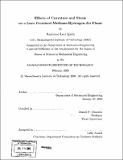| dc.contributor.advisor | Ahmed F. Ghoniem. | en_US |
| dc.contributor.author | Speth, Raymond L., 1981- | en_US |
| dc.contributor.other | Massachusetts Institute of Technology. Dept. of Mechanical Engineering. | en_US |
| dc.date.accessioned | 2007-01-10T16:54:30Z | |
| dc.date.available | 2007-01-10T16:54:30Z | |
| dc.date.copyright | 2006 | en_US |
| dc.date.issued | 2006 | en_US |
| dc.identifier.uri | http://hdl.handle.net/1721.1/35640 | |
| dc.description | Thesis (S.M.)--Massachusetts Institute of Technology, Dept. of Mechanical Engineering, 2006. | en_US |
| dc.description | Includes bibliographical references (leaves 74-77). | en_US |
| dc.description.abstract | The elemental flame is a subgrid model for turbulent combustion, parameterized by time-varying strain rate and curvature. This thesis develops the unsteady one-dimensional governing equations for the elemental flame incorporating detailed chemical kinetics and transport and a robust and efficient numerical method for solving the governing equations. Hydrogen enrichment of some hydrocarbon fuels has been shown to improve stability and extend flammability limits of lean premixed combustion in a number of recent experiments. It is suggested that these trends may be explained by the impact of hydrogen on the flame response to stretch and curvature. The elemental flame model is used to simulate premixed hydrogen-enriched methane flames in positively curved, negatively curved and planar configurations at varying strain rates. Curvature and stretch couple with non-unity species Lewis numbers to affect the burning rates and flame structure. Hydrogen addition is found to increase burning rate and resistance to flame stretch under all conditions. Positive curvature reinforces the effect of hydrogen enrichment, while negative curvature diminishes it. | en_US |
| dc.description.abstract | (cont.) The effects of strong curvature cannot be explained solely in terms of flame stretch. Hydrogen enriched flames display increases in radical concentrations and a broadening of the reaction zone. Detailed analysis of the chemical kinetics shows that high strain rates lead to incomplete oxidation; hydrogen addition tends to mitigate this effect. | en_US |
| dc.description.statementofresponsibility | by Raymond Levi Speth. | en_US |
| dc.format.extent | 77 leaves | en_US |
| dc.format.extent | 3218959 bytes | |
| dc.format.extent | 3222117 bytes | |
| dc.format.mimetype | application/pdf | |
| dc.format.mimetype | application/pdf | |
| dc.language.iso | eng | en_US |
| dc.publisher | Massachusetts Institute of Technology | en_US |
| dc.rights | M.I.T. theses are protected by copyright. They may be viewed from this source for any purpose, but reproduction or distribution in any format is prohibited without written permission. See provided URL for inquiries about permission. | en_US |
| dc.rights.uri | http://dspace.mit.edu/handle/1721.1/7582 | |
| dc.subject | Mechanical Engineering. | en_US |
| dc.title | Effects of curvature and strain on a lean premixed methane-hydrogen-air flame | en_US |
| dc.type | Thesis | en_US |
| dc.description.degree | S.M. | en_US |
| dc.contributor.department | Massachusetts Institute of Technology. Department of Mechanical Engineering | |
| dc.identifier.oclc | 76702737 | en_US |
